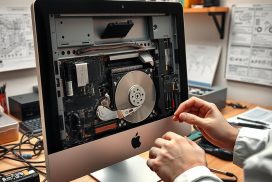Upgrading the SSD in Your iMac: A How-To Guide
Are you looking to boost the performance of your iMac? Upgrading the SSD can be the solution you need. An iMac SSD upgrade can significantly improve your device’s speed and overall performance, allowing you to enjoy a smoother and more efficient user experience. With faster application launch times, snappy startup, and increased data transfer speed, your iMac can run up to 10 times faster than before. Say goodbye to the waiting time associated with traditional hard drives and hello to instant access to your data.
Why settle for sluggish performance when an SSD upgrade can give your iMac a new lease on life? Not only does upgrading the SSD improve your iMac’s performance, but it also extends its lifespan. SSDs are more reliable and durable compared to mechanical hard drives, as they have no moving parts that can wear out. By upgrading, you can enjoy a more efficient and energy-saving device, contributing to cooler operation and a quieter user experience.
If you’re wondering how to upgrade the SSD in your iMac, don’t worry. There are different methods available, each with its own advantages. Whether you prefer using Time Machine to restore your data, cloning your existing hard drive, or performing a fresh installation of macOS, there’s an option that suits your needs. In the following sections, we’ll guide you through the step-by-step process of each method, ensuring a successful upgrade.
Why Upgrade Your iMac’s SSD?
Upgrading your iMac’s SSD offers several benefits. Firstly, it significantly improves performance by allowing applications to open quicker and reducing overall system lag. The increased speed can make your iMac feel like new again. Secondly, an SSD can extend the lifespan of your iMac by providing a more reliable and durable storage solution compared to mechanical hard drives. SSDs are less prone to physical damage and data loss due to their lack of moving parts. Additionally, an SSD consumes less power, which can contribute to energy efficiency and cooler operation, resulting in a quieter and more comfortable user experience.
To better understand the advantages of upgrading your iMac’s SSD, let’s explore each benefit in more detail:
Improved Performance
With an upgraded SSD, your iMac will experience a remarkable boost in performance. Applications will launch faster, and your overall system responsiveness will greatly improve. Say goodbye to frustrating lag and hello to a smooth and efficient computing experience.
Increased Speed
By upgrading to an SSD, you can enjoy lightning-fast speed on your iMac. Whether you’re booting up your computer or opening multiple programs simultaneously, an SSD will handle these tasks with ease, providing you with a seamless and efficient workflow.
Extended Lifespan
An SSD offers a more durable storage solution for your iMac. Unlike traditional mechanical hard drives, SSDs have no moving parts, which means they are less susceptible to physical damage and data loss. This increased reliability ensures that your iMac can serve you well for many years to come.
Upgrading your iMac’s SSD not only unlocks improved performance and faster speed but also enhances the overall lifespan of your device. Take the leap and experience the difference an SSD upgrade can make in optimizing your iMac’s performance and user experience.
Different Methods of Upgrading your iMac’s SSD
When it comes to upgrading the SSD in your iMac, there are several methods you can choose from. Each method has its advantages, allowing you to tailor the upgrade process to suit your specific needs and preferences. Let’s explore the different methods of iMac SSD upgrade:
1. Time Machine Restore
Using Time Machine to restore your data onto the new SSD is a convenient method. It enables you to migrate all your files, settings, and applications seamlessly. By selecting the latest Time Machine backup, you can transfer everything to the upgraded drive and maintain continuity in your iMac experience.
2. Cloning
Cloning is another method of upgrading your iMac’s SSD. With cloning, you create an exact copy of your current hard drive onto the new SSD. This method allows you to avoid the hassle of reinstalling software and ensures a smooth transition to the upgraded drive. It’s an excellent choice if you want to replicate your existing setup.
3. Fresh Installation of macOS
If you prefer starting with a clean slate, a fresh installation of macOS on the new SSD is an option worth considering. This method involves initializing the SSD and installing macOS from scratch. It allows you to customize your iMac to your liking and ensures a fresh and optimized operating system.
Each method offers its own set of advantages, so it’s essential to evaluate your requirements and choose the method that best aligns with your goals. Whether you opt for Time Machine restore, cloning, or a fresh installation of macOS, upgrading your iMac’s SSD will undoubtedly enhance its performance and improve your overall experience.
Note: The image provided above depicts an iMac upgrade, showcasing the various methods discussed in this section. The image illustrates the versatility and choices available for upgrading your iMac’s SSD.
Upgrade Process Using Time Machine
To upgrade the SSD in your iMac using Time Machine, follow these step-by-step instructions:
- Replace: Check if your existing drive is 3.5″ or 2.5″. If it is 3.5″, you’ll need a bracket for the new SSD. Remove the old hard drive and install the SSD according to the provided instructions.
- Restart: Plug in the Time Machine and restart your Mac while holding down the Command and R keys to enter Recovery Mode.
- Ready: Open Disk Utility from the OS Utilities page and format the SSD using the appropriate format type.
- Restore: Select the latest Time Machine backup and choose to restore it onto the new SSD. This will transfer all your files, settings, and applications to the upgraded drive.
Benefits of Upgrading with Time Machine
Upgrading your iMac’s SSD using Time Machine offers several advantages, including:
- Faster performance and improved speed
- Easy migration of files, settings, and applications
- Reliable data restoration from backups
By following this step-by-step guide, you can efficiently format your new SSD and restore your data from the Time Machine backup. This method ensures a seamless upgrade process and allows you to enjoy the benefits of an improved SSD without losing any important files or settings.
| Advantages | Disadvantages |
|---|---|
| Faster performance | Requires a compatible backup from Time Machine |
| Easy migration of files | May take some time to complete the restoration process |
| Reliable data restoration | Requires additional steps for formatting the new SSD |
Upgrading your iMac’s SSD with Time Machine not only improves performance and speed, but it also allows for a smooth transition by migrating all your important files and settings. Follow this step-by-step guide to experience the benefits of an upgraded SSD and enjoy a faster, more efficient iMac.
Upgrade Process Through Cloning
If you want to upgrade your iMac’s SSD through cloning, follow these step-by-step instructions:
-
Ready: Connect the new SSD to a spare USB port using a USB to SATA cloning cable.
-
Restart: Restart your Mac.
-
Restore: Download and install cloning software like Carbon Copy Cloner. Initialize the SSD using Disk Utility and clone your hard drive to the SSD.
-
Replace: When cloning is complete, power off your Mac and replace the old hard drive with the new SSD according to the provided instructions.
By following these steps, you can easily upgrade your iMac’s SSD through cloning. Cloning software, such as Carbon Copy Cloner, allows for a seamless transfer of data from your current hard drive to the new SSD. This method is ideal if you want to avoid reinstalling software and prefer a smooth transition. Once the cloning is complete, simply replace the old hard drive with the new SSD, and you’re good to go.
This process ensures that all your files, settings, and applications are transferred to the upgraded drive, allowing you to enjoy the benefits of an improved SSD without any hassle.
tab_image
Fresh Installation of macOS
To perform a fresh installation of macOS on the new SSD, follow these steps:
- Ready: Initialize the SSD and make it ready for the installation process.
- Restart: Restart your Mac.
- Replace: Replace the old hard drive with the new SSD.
- Restore: Insert the macOS USB or start Recovery Mode, and install macOS on the new SSD. You can then restore your data from a Time Machine backup or other external devices.
| Step | Description | |
|---|---|---|
| 1 | Ready | Initialize the SSD and make it ready for the installation process. |
| 2 | Restart | Restart your Mac. |
| 3 | Replace | Replace the old hard drive with the new SSD. |
| 4 | Restore | Insert the macOS USB or start Recovery Mode, and install macOS on the new SSD. You can then restore your data from a Time Machine backup or other external devices. |
Step 1: Ready
Before proceeding with the fresh installation of macOS, you need to initialize the new SSD to ensure it is ready for the installation process. Follow these steps:
- Connect the new SSD to your iMac using the appropriate cable.
- Power on your iMac and open Disk Utility from the Applications folder or Recovery Mode.
- Select the new SSD from the list of available drives.
- Click on the “Erase” button and choose the appropriate format for the SSD (e.g., APFS or Mac OS Extended).
- Give the SSD a name and click “Erase” to initialize the disk.
Step 2: Restart
After initializing the SSD, you need to restart your iMac to proceed with the fresh installation of macOS. Follow these steps:
- Save any open files and close all applications.
- Click on the Apple menu in the top-left corner of the screen.
- Select “Restart” from the drop-down menu.
Step 3: Replace
With the iMac restarted, it’s time to physically replace the old hard drive with the new SSD. Follow these steps:
NOTE: Before proceeding, make sure to consult the official documentation or seek professional assistance if you are unsure about the hardware replacement process.
- Power off your iMac and disconnect all cables.
- Open up your iMac using the appropriate tools.
- Locate the old hard drive and carefully disconnect it from the motherboard.
- Take the new SSD and connect it to the motherboard using the correct cables.
- Secure the new SSD in place and close up your iMac.
Step 4: Restore
Now that the new SSD is installed and your iMac is powered on, you can proceed with the fresh installation of macOS. Follow these steps:
- Insert the macOS USB installation media into a USB port.
- Restart your iMac while holding down the Option key.
- Select the macOS USB installation media from the list of available boot options.
- Follow the on-screen instructions to install macOS on the new SSD.
- Once the installation is complete, you can choose to restore your data from a Time Machine backup or other external devices.
Conclusion
Upgrading the SSD in your iMac is a smart investment that offers a host of benefits. By enhancing the performance and speed of your iMac, you can enjoy a smoother and more efficient computing experience. With the improved reliability and reduced load times provided by an upgraded SSD, your iMac will feel like a brand new machine.
Whether you choose to upgrade using Time Machine, cloning, or a fresh installation of macOS, the end result will be a system that operates at its best. Don’t miss out on the opportunity to optimize your iMac’s performance and unlock its full potential.
To ensure a successful and seamless iMac SSD upgrade, consider contacting a professional service provider or following a comprehensive guide. With their expertise and guidance, you can navigate the upgrade process with ease and enjoy all the benefits that come with an improved iMac.
FAQ
Why should I upgrade the SSD in my iMac?
Upgrading the SSD in your iMac can significantly improve its performance and extend its lifespan. An SSD upgrade allows for faster application launch times, snappy startup, and overall improved speed compared to traditional mechanical hard drives. With an SSD, your iMac can run up to 10 times faster, thanks to the increased data transfer speed. Additionally, an SSD operates differently from a traditional hard drive, allowing for instant access to data and eliminating the waiting time associated with spinning drives. Overall, upgrading your iMac’s SSD is a great way to optimize its performance and enhance your user experience.
What are the benefits of upgrading my iMac’s SSD?
Upgrading your iMac’s SSD offers several benefits. Firstly, it significantly improves performance by allowing applications to open quicker and reducing overall system lag. The increased speed can make your iMac feel like new again. Secondly, an SSD can extend the lifespan of your iMac by providing a more reliable and durable storage solution compared to mechanical hard drives. SSDs are less prone to physical damage and data loss due to their lack of moving parts. Additionally, an SSD consumes less power, which can contribute to energy efficiency and cooler operation, resulting in a quieter and more comfortable user experience.
What are the different methods of upgrading my iMac’s SSD?
There are multiple methods to upgrade the SSD in your iMac. The first method involves using Time Machine to restore your data onto the new SSD. This method is convenient because it allows you to migrate all your files, settings, and applications to the new drive. Another method is cloning, where you create an exact copy of your current hard drive onto the new SSD. This method is useful if you want to avoid reinstalling software and prefer a seamless transition. Lastly, a fresh installation of macOS on the new SSD is an option for those who want to start with a clean slate. Each method has its advantages, and the choice depends on your specific needs and preferences.
How do I upgrade my iMac’s SSD using Time Machine?
To upgrade your iMac’s SSD using Time Machine, follow these steps:
1. Replace: Check if your existing drive is 3.5″ or 2.5″. If it is 3.5″, you’ll need a bracket for the new SSD. Remove the old hard drive and install the SSD according to the provided instructions.
2. Restart: Plug in the Time Machine and restart your Mac while holding down the Command and R keys to enter Recovery Mode.
3. Ready: Open Disk Utility from the OS Utilities page and format the SSD using the appropriate format type.
4. Restore: Select the latest Time Machine backup and choose to restore it onto the new SSD. This will transfer all your files, settings, and applications to the upgraded drive.
How do I upgrade my iMac’s SSD through cloning?
To upgrade your iMac’s SSD through cloning, follow these steps:
1. Ready: Connect the new SSD to a spare USB port using a USB to SATA cloning cable.
2. Restart: Restart your Mac.
3. Restore: Download and install cloning software like Carbon Copy Cloner. Initialize the SSD using Disk Utility and clone your hard drive to the SSD.
4. Replace: When cloning is complete, power off your Mac and replace the old hard drive with the new SSD according to the provided instructions.
How do I perform a fresh installation of macOS on the new SSD?
To perform a fresh installation of macOS on the new SSD, follow these steps:
1. Ready: Initialize the SSD and make it ready for the installation process.
2. Restart: Restart your Mac.
3. Replace: Replace the old hard drive with the new SSD.
4. Restore: Insert the macOS USB or start Recovery Mode, and install macOS on the new SSD. You can then restore your data from a Time Machine backup or other external devices.












